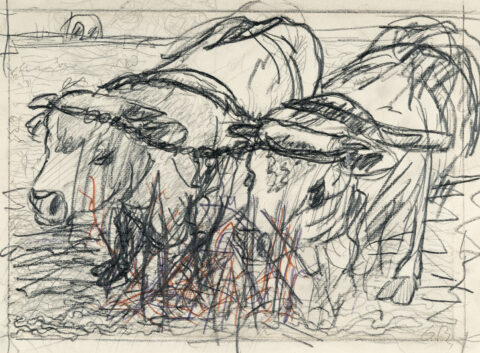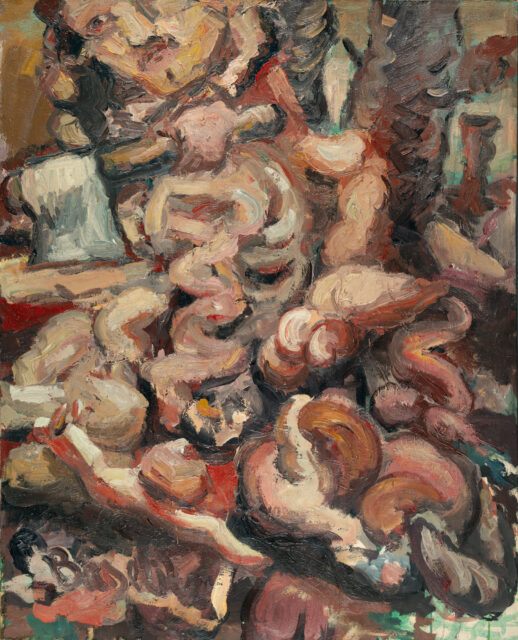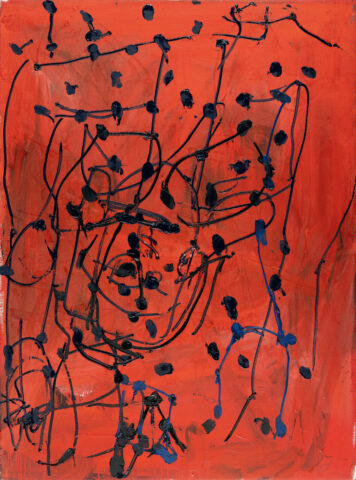
“Ein Werktätiger” (“A worker”)
Details
Provenance: Michael Hille, Berlin; Galerie Michael Haas, Berlin; Galerie Neher, Essen; private collection, Düsseldorf; Galerie Brigitte Ihsen, Cologne; Galerie Paul Maenz, Cologne; Phillips, New York 18.5.2000, lot 30; private ownership; Christie’s, London 21.6.2007, lot 338; Phillips, London 29.6.2017, lot 9;Chu Foundation, Hong Kong; Sotheby’s, Hong Kong 6.10.2020, lot 1103;private ownership, USA.
Descrizione
• Key work in Baselitz’s important series of Fraktur paintings from 1966 to 1969
• Provocative and challenging subject that combines the aesthetic and conceptual principles of Baselitz’s painting
• The Fraktur paintings were a central component of the major retrospective at the Centre Pompidou in Paris in 2021
• Georg Baselitz’s early work is figurative and wild – exactly the opposite of the abstraction and Art Informel, which were the predominant forms of contemporary painting in the early 1960s. He thus saw no chance of ever being able to exhibit his paintings in the galleries of Berlin, and decided instead to band together with his pupil and friend Eugen Schönebeck to organise their first joint exhibition in 1961. As location they chose a residential building in Berlin-Wilmersdorf that had been cleared for demolition. They even came up with a kind of advertising campaign, wrinting the “Pandemonic Manifesto”, an angry pamphlet in which both artists declared the ugly, obscene and blasphemous to be the most important themes of a new kind of figurative painting. A few years later, Baselitz developed one of his most important series of works, the so-called Frakturbilder, in which he attempted to find a new order for his emotional paintings. In these works, of which “Ein Werktätiger” is an outstanding example, Baselitz builds on the previous series of heroes. He creates a form of distorted figuration that ultimately leads to the first inversions or upside-down compositions, which he executed from 1969 onwards. The Fraktur paintings thus stand at the intersection of two important currents in the artist’s work: the desire to create a work that deals with the legacy of the Second World War and the need to find a new way of creating images that objectify and distort the subject without entering the realm of pure abstraction. In this depiction of an axe-wielding worker, the labourer splinters the canvas in every way; the pictorial field is fluidly and violently torn apart and fragmented in a schizophrenic and fragmented complexity. Like almost all the works that Baselitz created in the 1960s, “Ein Werktätiger” refers to the concept of the nation after the Second World War. It juxtaposes the nostalgia of the pre-war era, symbolised by the woodworker with the axe, with the horror of war. Baselitz’s Fraktur paintings are provocative, challenging and of groundbreaking significance. They represent the culmination of the aesthetic and conceptual principles that characterised his painting of the 1960s and laid the foundation for his artistic work of the following 50 years. “A Labourer” is an extraordinary painting that bears witness to the wild beauty and conceptual rigour that characterise Baselitz’s most outstanding works.
* Tutte le informazioni includono la commissione a carico dell'acquirente (27%) senza IVA e senza garanzia. Salvo errori.
** Tutte le informazioni più la commissione a carico dell'acquirente e l'IVA e senza garanzia. Salvo errori.
*** Con riserva: L'offerta è stata accettata al di sotto del limite. L'acquisizione dell'opera potrebbe essere ancora possibile nella nostra vendita post-asta.
R = Le opere d'arte regolarmente tassate
N = Opere d'arte soggette a tassazione differenziata e provenienti da un paese non UE
Non è consentita la riproduzione e la distribuzione privata o commerciale di tutte le illustrazioni delle opere esposte nell'archivio della mostra e dell'asta. Tutti i diritti riservati.




